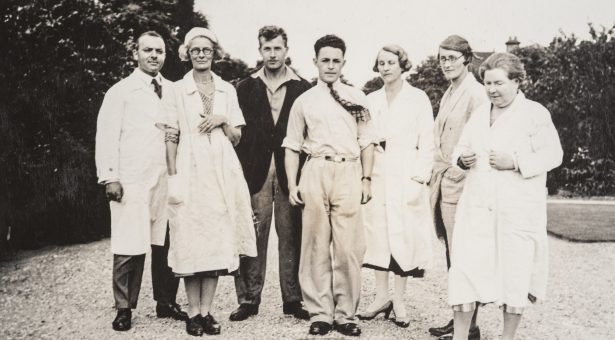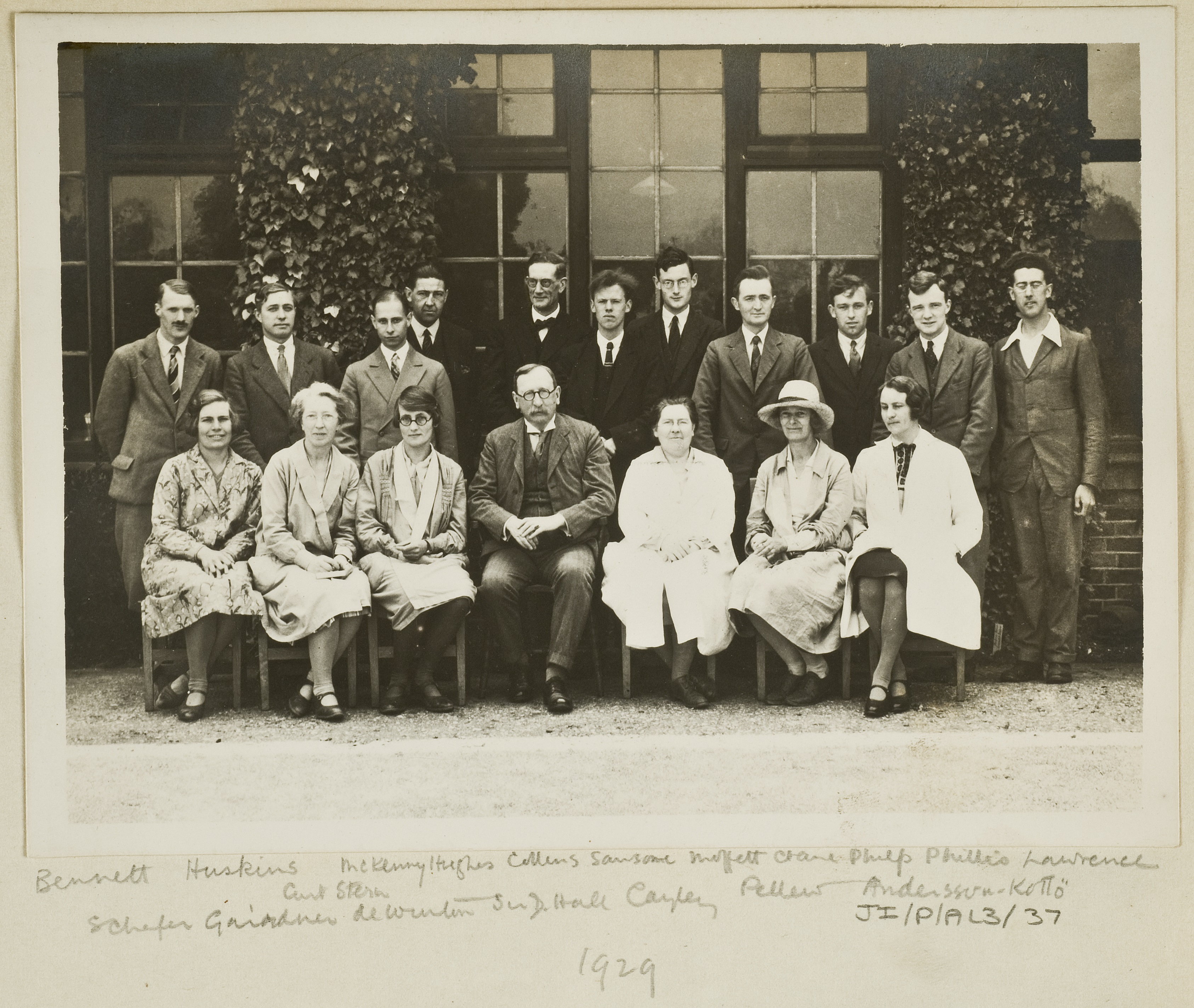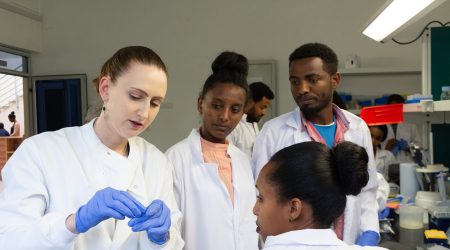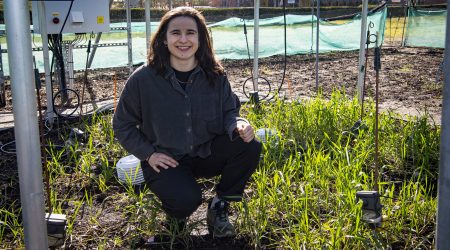A history of women in plant science

To celebrate International Women and Girls in Science day (11 February), archivist Sarah Wilmot explores the history of women in science, both at the John Innes Centre and before its formation. We take a journey through time to understand the barriers and celebrate the successes of those who were able to overcome those challenges to become scientists and technicians.
First let’s go back to the time before the John Innes Centre was founded. Women wanting to do scientific work faced many barriers. For instance, they couldn’t attend UK universities until the late 19th century.
Even when women were allowed to go to university their presence was strictly controlled with segregation to female only colleges, or segregated labs. Attempts to widen their access to higher education were often met with hostility. On occasion, as happened in Cambridge in 1897, the issue sparked mass protest and riots.
By this date all British universities, except Oxford and Cambridge, accepted women to degrees. At Cambridge, where the John Innes’s first director, William Bateson had first taught genetics, women could attend lectures, but many science professors would not accept women in their labs.
From 1921 they could take exams and gain a ‘titular degree’, which gave them the formal rights to attend university lectures and be admitted to university laboratories, but there was no actual graduation after all the hard work they had put in.
In fact, women were unable to gain a full degree until as late as 1948 at Cambridge. Oxford granted women full degrees from 1919.
The ‘titular degree’ denied women full university rights, including access to the junior posts and research fellowships that enabled men to get a foot on the scientific career ladder. Voluntary or grant-aided work with a male mentor, or a position in the few women’s colleges, or ladies’ labs, was often the only route for a woman to pursue scientific research.
What was the situation at the new ‘John Innes Horticultural Institution’?
From the time of its founding in 1910, the John Innes Centre has provided employment opportunities for women in science.
The institute began with only a few permanent scientific staff, and these posts were supplemented by volunteers, and minor and major ‘studentships’, which were open to both men and women for terms of up to 5 years.
While the major studentships were intended to be prestigious appointments akin to university fellowships, William Bateson was open about the fact that he envisaged that most of the minor studentships (worth £50-£100 per year) would be held by women.
How were women employed at John Innes in practice?
In practice, some women like Muriel Wheldale, began their John Innes careers with a major studentship. Others served an apprenticeship as either a ‘minor student’ or ‘technical assistant’ before progressing further.
Historian Marsha Richmond, reviewing the contribution of women to the institute before 1935, calculates that together they numbered 188 individuals, working as volunteers, assistants, students, and staff.
The first cohort of women to join the institute in the 1910s were from a variety of backgrounds, including graduates, women with diplomas in horticulture, and women with relevant work experience or a connection to Bateson.
Several did not have a university degree and so did not have the same formal science training as the Cambridge women Bateson had previously worked with (where most had taken the Natural Sciences Tripos). They were also often ‘ladies’ with private incomes.
The women appointed in the 1920s, and especially the 1930s, were more likely to be women with science degrees, working towards doctorates, and seeking careers in science. Salaries for these women were pegged below those of men (in the late 1920s, £200 – £300 a year, while the men’s salaries ranged from £250 – £400 a year).
Why did William Bateson strive to employ women?
In the early years of the institute, paid male and female researchers were present in equal (very low) numbers. During WWI, as the male workforce left to work in munitions or join the armed forces, there were four females to one male. Only one male researcher returned to the institute after the war. During the 1920s, up to Bateson’s death in 1926, paid women researchers generally outnumbered the men.
However there were several reasons for this pattern besides war disruption; one was that employing women made the institute’s budget go further. But equally important was the influence of the model of research that Bateson had established at Cambridge and found to work well.
Marsha Richmond has explained that this was a ‘domestic’ model, the research being run within an ‘extended family’ from Bateson’s country house in Grantchester.
Bateson and his wife Beatrice carefully mentored the women (and a few male) scientists attracted to Mendelian research, working in a close-knit group outside the mainstream biology curriculum and university departmental structures.
The John Innes Horticultural Institution closely followed this model, its gardens and experimental plots set out around Bateson’s new home, the Manor House at Merton Park in London. Bateson’s inclusion of women at the new institute was an entirely natural step given the antecedents of his British Mendelian programme.
What happened if women working in science got married?
At the time, there were restrictions on the employment of married women, called a marriage bar. For example, until 1919 married women were barred from teaching. In the civil service the marriage bar operated until 1946, and much later for the foreign service. During WWI and WW2, the marriage bar in the Post Office was lifted, but only temporarily.
However, women were able to continue scientific research after marriage, as there was no ‘marriage bar’ to women working in this field.
At the John Innes institute, some women chose to resign on marriage and follow their husband’s career. But others chose to continue to work, only stopping when childcare responsibilities made work outside the home difficult. Some women were able to continue their research projects after having children, particularly during the summer months.
As Marsha Richmond notes, ‘The situation at the institution was conducive to this arrangement, since the institute staff grew and maintained their plant material, and researchers generally only needed to visit the institution in the late summer, when the time came for scoring and analysing the results.’

Acknowledgment and Further Reading
I am grateful to Professor Marsha Richmond for her many articles on women in early genetics and for allowing me to see a draft chapter on the history of women geneticists at the John Innes Horticultural Institution. Quotations are from Marsha’s manuscript and Wilmot 2017.
Read more about the contribution of women to early genetics, both at John Innes and from an international perspective in Marsha Richmond’s forthcoming co-authored book (with Ida Stamhuis) Genes and Gender: Women in the Emergence of Genetics, 1900-1940, in preparation.
The book will include reflections on how the story of women at John Innes compares with that of women geneticists employed at other experimental institutes, including Cold Spring Harbor, New York, and Erwin Baur’s Institute for Heredity Research in Berlin.
For more information about John Innes women researchers see Sarah Wilmot (2017): ‘JBS Haldane: the John Innes years, Journal of Genetics, Vol. 96, No. 5, pp. 815–826.



